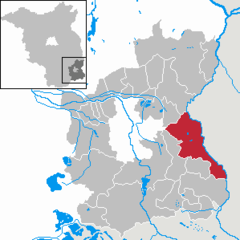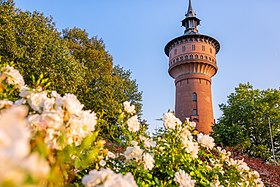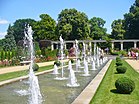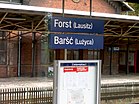Forst (Lausitz)
Baršć (Łužyca) | |
|---|---|
|
From top: water tower St Nicholas' Church church in Naundorf (Glinsk) Ostdeutscher Rosengarten Forst (Lausitz) station view from St Nicholas' Church | |
Location of Forst (Lausitz) within Spree-Neiße district  | |
| Coordinates: 51°44′N 14°38′E / 51.733°N 14.633°E | |
| Country | Germany |
| State | Brandenburg |
| District | Spree-Neiße |
| Government | |
| • Mayor (2018–26) | Simone Taubenek[1] |
| Area | |
| • Total | 109.91 km2 (42.44 sq mi) |
| Elevation | 72 m (236 ft) |
| Population (2022-12-31)[2] | |
| • Total | 17,855 |
| • Density | 160/km2 (420/sq mi) |
| Time zone | UTC+01:00 (CET) |
| • Summer (DST) | UTC+02:00 (CEST) |
| Postal codes | 03141–03149 |
| Dialling codes | 03562 |
| Vehicle registration | SPN |
| Website | www.forst-lausitz.de |
Forst (Lausitz) (German) or Baršć (Łužyca) (Lower Sorbian, pronounced [ˈbarɕtɕ ˈwuʒɨtsa]) is a town in Lower Lusatia, Brandenburg, in eastern Germany. It lies east of Cottbus, on the Lusatian Neisse river which is also the German-Polish border. It is the capital of the Spree-Neiße district. It is known for its rose garden and textile museum. The town's population is 18,651. In Forst, there is a railway bridge across the Neiße belonging to the line Cottbus–Żary which is serviced by regional trains and a EuroCity train between Hamburg and Kraków (2011). There is also a road bridge across the river north of Forst.
- ^ Landkreis Spree-Neiße Wahl der Bürgermeisterin / des Bürgermeisters Archived 2021-07-09 at the Wayback Machine, accessed 2 July 2021.
- ^ "Bevölkerungsentwicklung und Bevölkerungsstandim Land Brandenburg Dezember 2022" (PDF). Amt für Statistik Berlin-Brandenburg (in German). June 2023.









